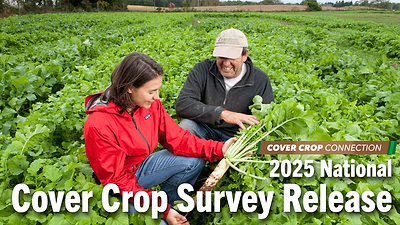“When we hear soil disturbance, we think about tillage, but that can also come from planting or terminating your crops. Any type of soil disturbance can activate any of the weeds in the soil seed bank. By waiting until the cereal rye is at boot stage and then planting green, you're gaining that benefit of minimizing your soil disturbance and adding to the aboveground biomass.”
— Megan Czekaj, Graduate Student, Penn State University Weed Science Lab
In this episode of the Cover Crop Strategies podcast, brought to you by GS3 Quality Seed, I’m joined by Penn State University graduate student Megan Czekaj, as we discuss her research on best practices for applying residual herbicides when planting green. Her project focuses on cereal rye in soybean systems and delves into termination timing, cover crop biomass levels and lots more.
Check out this video from GROW IWM that summarizes Megan Czekaj's original multi-state study on applying residual herbicides when planting green.
Related Content
- When Is the Best Time to Terminate Cereal Rye to Suppress Weeds & Protect No-Till Soybean Yield?
- Considerations for Planting Green
- Potential Impacts of Different Herbicides When Interseeding Cover Crops
- Tips for Integrating Residual Herbicides and Cover Crops
The Cover Crop Strategies podcast series is brought to you by GS3 Quality Seed.
Trying to improve your water infiltration? Reduce erosion? Or attract pollinators? How about increase your organic matter? At GS3 Quality Seed, we produce and market cover crops that will help you address your soil health concerns. With knowledgeable dealers located throughout the United States, we offer a wide array of experience and support. Visit our website to find a dealer near you.Full Transcript
Mackane Vogel:
Welcome to the Cover Crop Strategies podcast, brought to you by GS3 Quality Seed. I'm Mackane Vogel, associate editor at Cover Crop Strategies. In this episode, I'm joined by Penn State University graduate student, Megan Czekaj, as we discuss her research on best practices for applying residual herbicides when planting green. Her project focuses on cereal rye and soybean systems, and delves in determination timing, cover crop biomass levels, and lots more.
So I'm joined today by Megan Czekaj. She is a graduate student. Megan, you want to just introduce yourself to the audience, and then I always like to start these the same way by just asking what your ag origin story is or just your earliest memories related to agriculture.
Megan Czekaj:
Sure. Thank you so much for having me today. I'm honored to be here and talk a little bit more about what I've been doing. So this is actually a really interesting question. I actually have no background in agriculture, but I can remember being in school and just every science fair project I've ever done was relating to plants.
I can remember my dad and I had chestnut trees and I was growing them under different watering experiments where it was with soda, juice, water. So I've always had an interest in plants. When I got into college, I took a job at the Penn State Weed Science Lab under John Wallace, and I really just found my passion for studying weed science and just really fell in love with learning all about the different kinds of weeds and being able to identify these weed species and knowing just a little bit more about if they are invasive, how to slightly manage. That is really just what drew in my passion for weed science and how I ended up majoring in plant science as an undergrad and then continuing it as a master's student.
Mackane Vogel:
Wow. Super cool. Yeah, I always love asking that question because everyone finds their way into it in different ways, but that is a really cool story. So the majority of our discussion today is going to be about your project, about how best to apply residual herbicides when planting green. So I guess to get into it a little bit, what made you decide on that as a study that you wanted to look into?
Megan Czekaj:
Sure. So while I was under this lab with Dr. John Wallace studying weed science, I was an undergrad in his lab and I actually asked him if I... I had graduated, I didn't quite have a plan set up yet, so I had asked him if I could stay for the summer and just help out with the lab and begin to work.
And so little did I know, John put me in charge of several projects. And about halfway through the summer, I decided to continue my education and get my master's degree. So these little projects that I had just been in charge of ended up being my master's project. So I kind of fell into it, and I'm so glad that I did because I have learned a lot throughout this whole experience. But it was kind of, I guess you could say a happy accident where I was just kind of staying for the summer and then all of a sudden these became my projects and I got to run with them.
Mackane Vogel:
Awesome. All right. Well, let's talk a little bit more about it. So for the study, I guess let's get into how it was laid out, maybe if you want to talk about the different states that were used and just some of the methodology that set it up.
Megan Czekaj:
So this experiment was completed across three different states. The main location where I was was at Penn State University here in State College, and then the other locations were completed at the University of Delaware and then at Virginia Tech. So we have Pennsylvania, Delaware, and Virginia, which is where the study was being replicated, and it was replicated over two years. So that allowed me to have six site years worth of data, which was pretty awesome to have completed in the course of two years.
And so the experimental design of this project was set up where we were really focused on this idea of farmers who already were using cover crops. So that was our control where the standard practice was farmers incorporating cover crops, but terminating them two weeks prior to soybean planting. So that was kind of our standard practice. And then we wanted to expand upon that with our planting green scenarios, which is really where we just wanted to use that as a weed suppression tactic.
So we had planting green early, which the cereal rye had reached about boot stage, and instead of terminating it, we planted the soybeans early. So that was an early soybean planting date while still planting green. And then we had a late planting green treatment where we allowed the cereal rye to reach almost full maturity at cereal rye anthesis. And then we incorporated a roll crimper to lay down the cereal rye and plant the soybeans directly. So it was all just a one big moving pass where it was being rolled in the front of the tractor, planted in the back of the tractor.
And as far as our residual herbicide applications go, we had a untreated control where there was still herbicides being used, but there were no residual herbicides. And then we had three different timings for a one-pass residual herbicide, which was pyroxasulfone. And then we were comparing that to a two-pass residual herbicide program.
So we were really trying to identify a lot of different moving parts and just how to better be able to recommend something for a farmer who is interested either planting green early to try to maximize the soybean growing season, or planting green late to try to get that higher cereal rye yield as a tactic to suppress weeds. So all of these different things have different practices that would be recommended for a residual or a herbicide program, and it's not just a one size kind of fits all. So it was a really interesting study and we found a lot of neat results from this. So yeah, that was kind of how the experiment was set up.
Mackane Vogel:
So then what would you say was... I guess, walk us through some of the patterns I guess that you saw and some of the findings.
Megan Czekaj:
So for the untreated control, we definitely... Oh, I guess I should also mention that in Pennsylvania, our weed species that we were focused on was water hemp, common water hemp. And in Delaware and Virginia, they focused on palmer amaranth, and we were able to combine these weed species just because of their vast similarities with the way they uptake herbicides, they're growing, they're flowering. There was just a lot of crossover. So we did use different weed species, but in the results that I kind of talked about, we categorized them together.
So in the untreated control, we definitely saw the highest flush of these weed species, which is what we expected. Now when we get into comparing the one-pass to the two-pass programs, we did see overall better control in our two-pass residual herbicide program. However, of these three different one-pass residual herbicide timings, regardless of when the soybeans were being planted, either the planting green early or planting green late, we saw that when there was a residual herbicide made at the time of planting, we saw a greater weed control with just the one-pass program.
But like I had mentioned, when we're comparing the one to the two-pass, we did see greater control with the two-pass program. But we saw very promising results when we were applying the residual herbicide at the time of planting, regardless of planting green early or late.
Mackane Vogel:
We'll come back to the discussion in a moment, but first, I'd like to thank our sponsor, GS3 Quality Seed for supporting today's podcast. Trying to improve your water infiltration, reduce erosion, or attract pollinators? How about increase your organic matter? GS3 Quality Seed produces and markets cover crops that will help you address your soil health concerns. With knowledgeable dealers located throughout the United States, they offer a wide array of experience and support. Visit their website to find a dealer near you, at www.tilthpro.com. That's T-I-L-T-H pro.com.
Thinking of attending the National Strip-Tillage Conference in August? Use the promo code GS3 to receive 15% off your 2024 National Strip-Tillage Conference registration. Head to striptillconference.com to register with the promo code. Once again, that's promo code GS3 for 15% off.
And now let's get back to the discussion with Megan Czekaj. You said it was two years, so that was something that was pretty much the same both years, you'd say?
Megan Czekaj:
Yeah, so definitely since I was in Pennsylvania, I was able to actually see what was going on. And so that was pretty consistent with both years in Pennsylvania. And so when we look at Delaware and Virginia, it was rather consistent, but I will say that we had a little bit of crazy weather also in Pennsylvania where in May of 2023 we experienced a drought, and so we actually had to use some irrigation to try to create an environment that wouldn't completely destroy this whole experiment.
So there was a little bit of inconsistencies as far as weather goes, and the inconsistencies are consistent within farming to begin with, but because we were creating that kind of, quote, unquote, "perfect environment," we did see consistencies when applying that residual at the time of planting did result in that greater control.
Mackane Vogel:
Yeah, obviously I think almost everyone was experiencing drought last year at some point, just a super dry year. And this year it's been the... I don't know about by you, but it's been sort of the opposite, really wet to start out.
Megan Czekaj:
Yes, that is exactly what we're experiencing right now. We get a couple hot days and then it rains for three or four days.
Mackane Vogel:
Yep, exactly. But as you said, it's the nature of farming, so weather is always going to be a part of the equation there. I guess let's talk a little more generally about what are some of the benefits of planting green in general? Why this might be something that farmers might want to take a look at if they haven't yet?
Megan Czekaj:
Sure. So with planting green, I kind of already mentioned this, but I think the biggest takeaway is just the potential for weed suppression. Whether you're planting green early and only allowing the cereal rye to reach the boot stage or waiting until anthesis to have a larger amount of biomass. And even with, I think the benefit to planting green early is instead of going out and terminating two weeks before you're planting your soybeans, you can just do that all at one go. So the trade-off between planting green early and the standard practice of terminating the cover crop, there's not a huge difference there.
And so I think that can be a huge benefit to farmers is that you're utilizing the above ground biomass to shade out any early season weeds. And it also, I would believe, helps with the ground cover and soil disturbance. I know a lot of times when we hear soil disturbance, we think about tillage, but that could also be planting or going in and terminating your crops. So any sort of soil disturbance can activate any of the weeds in the soil seed banks. So by waiting until the cereal rye is at boot stage and then planting green, you're gaining that benefit of maybe minimizing your soil disturbance and having the above ground biomass.
And similarly with planting green on anthesis, cereal rye anthesis, typically you would have a much larger amount of above ground biomass that would also help with shading the soil. And it's a much larger amount of surface mulch, which is also creating some cooler soil conditions and temperatures, which can also favor the cash crop rather than your weed species. So those are just some of the general positives to planting green.
Mackane Vogel:
Yeah, I think you make a good point about soil disturbance too. Obviously, tillage is the main thing, but yeah, that's a valid point. There's a lot of other ways that you can definitely do some disturbance to the soil. What do you think might be the reason for the lower cover crop biomass that you guys saw in this study
Megan Czekaj:
In Pennsylvania, forgive me, I forget if it was our first or our second year, but one of the years we did have a lower amount of cereal rye biomass, and that was in part due to our nitrogen levels in the soil. And then in Delaware, overall for both of the years, we had pretty low cereal rye biomass, and that is typically due to just their soil conditions. They have a much sandier soil. And so they typically always generally see a much lower amount of cereal rye biomass.
And I know that there's a lot of papers out there that recommend having at least 5,000 pounds per acre of the cereal rye biomass to successfully suppress weed species, but even with these lower amounts of cereal rye biomass that we saw across Pennsylvania, Delaware, and Virginia, we still were able to see a decent amount of weed suppression just based off of the cover crop alone without looking at any of the residual herbicides.
And so that was also, I think, eyeopening that you don't need... If you're considering planting green, but you don't think you can reach these really high levels of cereal rye biomass production, you don't necessarily need to be reaching those much higher levels to see weed suppression happening. So that was something that was like, "Well, maybe there can be a different consideration that wouldn't necessarily scare off a farmer if they're worried about reaching these really high levels of cereal rye biomass."
Mackane Vogel:
Yeah, I think that's a really good point too. And along those same lines, so were you guys able to kind of determine whether or not planning green can provide a season-long weed suppression? I guess what was the verdict there?
Megan Czekaj:
Yeah, so the overall verdict for a season-long weed suppression would be to use a two-pass residual herbicide program. That was our best program for suppressing the water hemp and palmer amaranth. Now, as far as trying to get that out of a one-pass program and still planting green, there's a lot of trade-offs. I can't come on here and say that there was one much better than the other.
And it also depends on where the farmer would be farming and state depending. So in Pennsylvania, setting aside the two-pass residual program, we saw that we were seeing adequate weed suppression with our planting green late, so we were allowing the cereal rye to reach anthesis and incorporating a one-pass residual program at that time of planting, is we were able to see almost equal amount of control when comparing it to the two-pass. So I would say that would be my best answer of that question for a season-long weed suppression.
Mackane Vogel:
What would you say was your biggest surprise or something that you guys learned during the study that you really maybe didn't expect to see?
Megan Czekaj:
Yeah, so I think something that we didn't expect to see, and it kind of got us to think about some other stuff, was that we didn't have a true control. So we didn't have just a soybean planting into no cover crops, no planting green. So I think that is something that we would take forward onto some of the next steps. And so I say that because some things that we saw that were interesting throughout this study with the no residual herbicides. And some of these aspects, we were seeing some decent control with that.
And so I think it really would've enhanced the project if we had a true no cover crop or a cereal rye control with the standard practice of terminating the cover crop two weeks beforehand and then our planting green scenarios. So that was pretty interesting. And also, I think we had already mentioned this, but really just the cereal rye biomass and that we were seeing control even though we did have lower amounts of the recommended biomass for control.
Mackane Vogel:
And then I think at the end of your summary video on the study, you mentioned research might be needed. I guess if you were in charge of a follow-up study for this, what would that look like? What do you think would be the next step here?
Megan Czekaj:
Yeah. I think, so I mentioned a little bit just adding in that control where you're just planning soybeans into a standard practice, no planting green, no cover crops. And also, I know for in Pennsylvania, we used water hemp and we actually, it was an artificial population. So come the season beforehand in the December-ish, we went out and artificially spiked water hemp plants. Prior to this experiment, there were no water hemp populations at this field. And so I think that's an advantage and a disadvantage because we saw water hemp germinate, but in a true scenario if a farmer had these water hemp problem, we kind of are lacking that experience because our seed banks are artificial.
So I think taking this a step further would be to reach out to a farmer in Pennsylvania or in a surrounding area that already has a natural water hemp population, and to complete some of these experiments to see how these natural populations are reacting to our herbicide program and our planting green tactics.
Mackane Vogel:
That's all for this episode of the Cover Crop Strategies podcast. Thanks to Megan Czekaj for that great discussion. The full transcript of this episode, as well as our archive of previous podcast episodes are available at covercropstrategies.com/podcasts. Many thanks to our sponsor, GS3 Quality Seed for helping to make this Cover Crop podcast series possible. From all of us here at Cover Crop Strategies, I'm Mackane Vogel. Thanks for listening and have a great evening.











